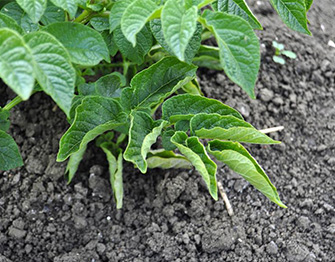Symptoms
Primary symptoms, those exhibited during the year of infection, are often slight and may be missed. A slight rolling and red/orange tinge can occur in the upper leaves. Secondary symptoms, those following the year of infection, vary. The bottom leaves may roll (See Image) and the leaves are dry and brittle and have a papery feel. The plant show a slight yellowing and upturning of the upper leaves. Plant growth can be marginally reduced or extremely stunted dependent on variety and conditions.
Leaf rolling caused by blackleg or stem canker will usually have additional stem symptoms.
Transmission
PLRV is transmitted by aphids in a persistent manner- once an aphid acquires the virus it is infective for life. The virus is picked up by colonising aphids during prolonged feeding on an infected plant. The peach potato aphid (Myzus persicae) is regarded as the most efficient vector.
Control
Current flush through seed certification schemes combined with roguing and aphicides provide effective protection against colonising aphids. Although potential alternative hosts are not widely grown in the main GB seed growing area’s, groundkeepers and volunteers should be eliminated during the rotation between potato crops. Care must be taken to alternate aphicide products with different modes of action to minimise selection for resistant aphids in any given population.
